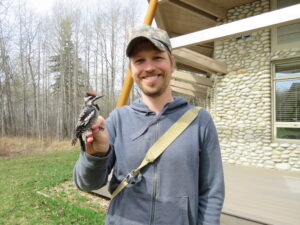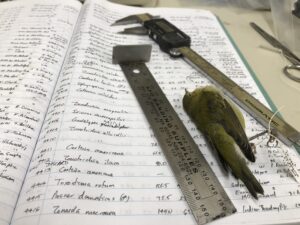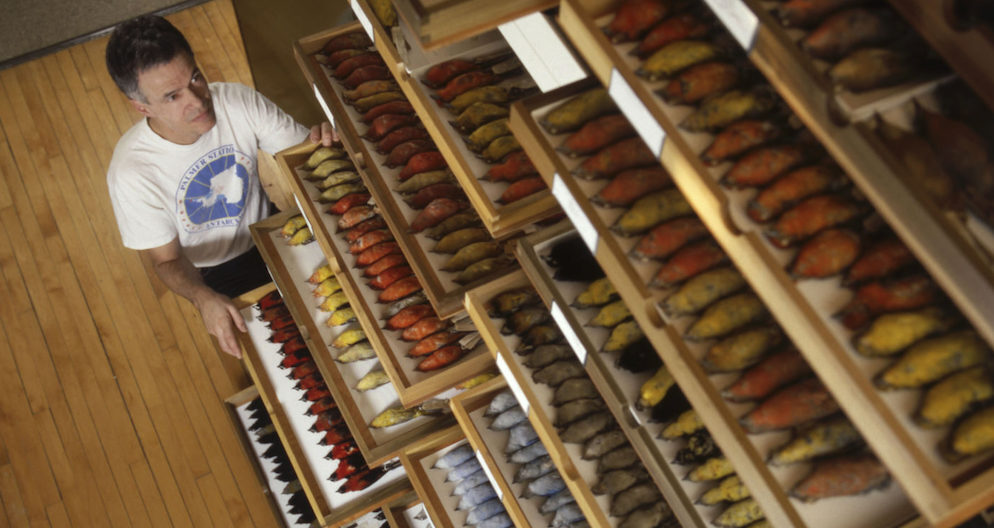Incredible shrinking birds
North American migratory birds have been getting smaller over the past four decades, and their wings have gotten a bit longer. Both changes appear to be responses to a warming climate.
Those are the main findings from a new University of Michigan-led analysis of a dataset of some 70,000 North American migratory birds from 52 species that died when they collided with buildings in Chicago.

U-M biologist Brian Weeks, lead author of a new study on avian responses to climate warming. (Image: Brian Weeks.)
Since 1978, Field Museum personnel and volunteers have retrieved dead birds that collided with Chicago buildings during spring and fall migrations. For each specimen, multiple body measurements are made.
The research team analyzed this remarkably detailed dataset to look for trends in body size and shape. The biologists found that, from 1978 through 2016, body size decreased in all 52 species, with statistically significant declines in 49 species.
Over the same period, wing length increased significantly in 40 species. The findings were published Dec. 4 in the journal Ecology Letters.
“We had good reason to expect that increasing temperatures would lead to reductions in body size, based on previous studies. The thing that was shocking was how consistent it was. I was incredibly surprised that all of these species are responding in such similar ways,” says study lead author Brian Weeks, an assistant professor at the U-M School for Environment and Sustainability (SEAS).
The senior author is Benjamin Winger of the U-M Department of Ecology and Evolutionary Biology and the Museum of Zoology. Weeks worked on the project as a postdoctoral researcher in Winger’s lab. Co-authors include David E. Willard, the Field Museum ornithologist and collections manager emeritus who measured all 70,716 birds analyzed in the study.
A causal relationship

U-M evolutionary biologist Benjamin Winger with some of the migratory songbirds used in a large study of avian responses to climate warming. (Image: Roger Hart, Michigan Photography.)
The new study is the largest specimen-based analysis of body-size responses to recent warming, and it shows the most consistent large-scale responses for a diverse group of birds, says Weeks.
Several lines of evidence suggest a causal relationship between warming temperatures and the observed declines in avian body size, according to the researchers. The strongest evidence is that — embedded within the long-term trends of declining body size and increasing temperature — there are numerous short-term fluctuations in body size and temperature that appear to be synchronized.
“Periods of rapid warming are followed closely by periods of decline in body size, and vice versa,” Weeks says. “Being able to show that kind of detail in a morphological study is unique to our paper, as far as I know, and it’s entirely due to the quality of the dataset that David Willard generated.”
“It’s really been a herculean effort on the part of Dave and others at the Field Museum, including co-author Mary Hennen, to get such valuable data from birds that might otherwise have been discarded after they died from building collisions,” Winger says.
Within animal species, individuals tend to be smaller in warmer parts of their range, a pattern known as Bergmann’s rule. And while the possibility of body size reduction in response to present-day global warming has been suggested for decades, evidence supporting the idea remains mixed.The uncertainty is likely due, in part, to the scarcity of datasets like the Field Museum trove.
For each bird, Willard measured the length of a lower leg bone called the tarsus, bill length, wing length, and body mass. In birds, tarsus length is considered the most precise single measure of within-species variation in body size.

Handwritten ledger in which Field Museum ornithologist and collections manager emeritus David Willard tracks the bird data. (Image: Field Museum, Kate Golembiewski.)
The data analysis reveals that:
- Three measures of body size — tarsus length, body mass and PC1, a common measure of overall body size that combines several key body-part measurements — showed statistically significant declines. Tarsus length declined 2.4 percent across species.
- Wing length showed a mean increase of 1.3 percent. Species with the fastest declines in tarsus length also showed the most rapid gains in wing length.
- Mean summer temperature was significantly negatively associated with bird body size — meaning that body size decreased significantly as temperatures warmed. Temperatures at the birds’ summer breeding grounds north of Chicago increased roughly 1 degree Celsius (1.8 degrees Fahrenheit) over the course of the study.
Studies of plant and animal response to climate change often focus on shifts in the geographical range of a species or the timing of events such as springtime flowering and migration. The consistency of the body-size declines reported in the new study suggests that such changes should be added to the list of challenges facing wildlife in a rapidly warming world, Weeks says.
“It’s clear that there’s a third component — changes in body size and shape — that’s probably going to interact with changes in range and changes in timing to determine how effectively a species can respond to climate change,” he says.
Nature’s wonder

Some of the birds collected at Chicago’s McCormick Place that are in the Field Museum collections, including an eastern meadowlark (far left) and an indigo bunting (far right). (Image: Field Museum, Karen Bean.)
Long-distance bird migration is one of the most impressive feats in the animal kingdom. The extreme energetic demands of flying thousands of miles have shaped the morphology of migrating birds — their form and structure — for efficient flight.
The authors of the Ecology Letters paper suggest the body-size reductions are a response to climate warming and that increased wing length may help offset the body-mass losses.
The researchers plan to test that idea in a follow-up project, which will again make use of the Field Museum dataset. They’ll also look further into the mechanism behind the body size and shape changes and whether they are the result of a process called developmental plasticity, the ability of an individual to modify its development in response to changing environmental conditions.
The birds analyzed in the study are small-bodied songbirds that breed north of Chicago in the summer and migrate through the region in high numbers. Several species of sparrow, warbler, and thrush make up the majority of the dataset, with thousands of individuals of each species documented as lethal collisions.
The observed changes in avian body size and shape are subtle — at most a couple grams’ difference in body mass and a few millimeters in wing length — and are not detectable with the naked eye. The Field Museum bird collision dataset highlights the value of natural history museum specimen collections, which help scientists understand how nature changes through time, the authors note.
“When we began collecting the data analyzed in this study, we were addressing a few simple questions about year-to-year and season-to-season variations in birds,” says the Field Museum’s Willard. “The phrase ‘climate change’ as a modern phenomenon was barely on the horizon. The results from this study highlight how essential long-term data sets are for identifying and analyzing trends caused by changes in our environment.”
The authors of the Ecology Letters paper, in addition to Weeks, Winger, Willard, and Hennen, are Marketa Zimova of the Institute for Global Change Biology at the U-M School for Environment and Sustainability, former U-M undergraduate Aspen A. Ellis, and Max L. Witynski of the Field Museum.
Funding for the study was provided by the Field Museum and the University of Michigan’s Department of Ecology and Evolutionary, Museum of Zoology, and Institute for Global Change Biology.
Top image: Field Museum ornithologist and collections manager emeritus David Willard, who measured all of the more than 70,000 migratory birds analyzed in the study. (Credit: Field Museum, John Weinstein.)




Mike Jefferson - 1979
It appears from a variety of reasonable sources that the total number of birds is declining. Blaming “global warming” is but one speculation and is a “rush to judgement”. There are many other possible causes including loss of habitat, loss of food sources, chemicals, plastics, or a myriad of other threats. Ironically, archeologists recently discovered a 9000 year old settlement which had the earliest evidence of human attempts to mitigate rising seas. How is it that with no cars, planes, or polluting factories that neo-lithic humans could have caused, “global warming” and rising seas? Don’t try to answer that rhetorical question. Should I surrender my money and livelihood to the priestly global warming class now?
Reply
Mark Dettling - 2001
Hi Mike, I’m glad you were interested enough to look at this article about some really cool research and that you heard about other studies that show an alarming decline in a number of bird species populations continent wide over the last 50 years. These studies give us great insight into bird ecology and conservation that may lead to further studies or conservation actions. This study documents how bird size is changing in response to some driving factor, and the fact that so many species are changing in the same way would lead one to hypothesize that the driving factor was on a continent wide scale. One such factor is human caused climate change, but as you mention there could be other factors involved like a change in prey items due to pesticides. These factors as well as cats (both feral and pet), collisions with windows, and habitat loss are all human related factors contributing to the massive loss of bird populations. The birds around us indicate the health of the environment we live in. Since the causes are all human related we have an obligation to act, not only to save the birds, but to create a functioning ecosystem that supports human life. We are not separate from nature.
I also have to respond to your rhetorical question, because I think you misunderstood the findings of the archaeologists. It sounds like they found evidence of humans responding to rising sea levels caused by a shift in the global climate some 9000 years ago. They are not claiming that humans caused that climate shift, just that they were responding to the change. We’ve found evidence of many shifts in the earth’s climate (e.g. the ice age) caused by various non-human related factors. With the knowledge of those previous shifts, climate scientists all agree that the climate change we are seeing today is caused by the increase in the concentration atmospheric greenhouse gases from human activity. So just like those neolithic humans, we should recognize the changes in the world around us and react to them, not ignore them because it might hurt your pocket book.
Reply
Donald Axelrad - U of M 1970
Shouldn’t Bergmann’s rule be mentioned somewhere in this article?
Reply
Carl Shubitowski - 1989
Very interesting research. We do have an obligation as humans to be caretakers of this planet for all species, not just our own. If we are the cause of species declining we should look at ways to mitigate the damge we created.
Reply